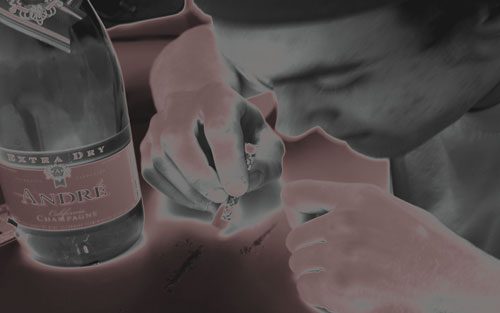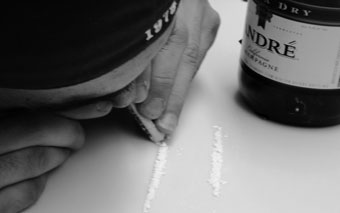Cocaine
by Allie Pohl


The Monster Cocaine
A powdery white substance sits before me. I have a long night ahead of me. My hands shake as I role up my Andrew Jackson. My mind is telling me to stop, but I am seductively pulled to its charm. I know the deadly consequences which can occur. But I need a fix. My body needs a boost. I have been up two days straight for finals. I have no choice. The rows of cocaine sit before me like jail bars. I feel trapped. An uncontrollable force pulls my head down toward the table. My conscience is screaming to stop but it’s too late. My mind and body are infatuated. One…snort. Two…snort. Three…snort. The monster has now pierced through my body.
A monster, is typically thought of as a mythical creature that sets out to
destroy. In books, movies, and theatre, monsters provide drama. In the real
world, where monsters like Dracula and Frankenstein do not exist, drugs are
what annihilate their victims. Once thought of as a harmless drug, cocaine
is now considered the most addictive and prevalent drugs in today’s
society. It is a stimulant that has turned the modern world upside down. All
social casts are subject to the evils of this drug. Once thought of as an
expensive designer drug for the wealthy, cocaine has spread through all social
classes. Like fictional monsters, cocaine can come in many forms: powder,
liquid, and crystallized. A person’s body can consume the substance
in a number of ways: snorting, injection, and smoked (Cocaine Crack). The
fictional monster that is similar to cocaine’s use of transformation
in order to destroy is Stoker’s Dracula. Dracula is able to take on
many different forms. He does this to get what he needs. The Count can appear
in a human form. He can also transform himself into a wolf and have command
over the wolves. The monster can make himself appear as a bat. He also possesses
the capacity to disassemble and turn into a silky mist: “He came up
the window in a mist, as I had seen him often before, but he was solid then,
not a ghost” (Stoker 244). Like cocaine, the Count is a monster who
changes form to integrate into human blood and turn humans into monsters.
Similarly, cocaine seeps into the human system and then the monster is released.
Cocaine turns into a monster as soon as it hits the blood steam
because of a chemical reaction that is induced. Cocaine affects the user,
then the user is transformed into a monster for the duration of time that
the drug is in its consumers body (Freud 175). This effect is similar to the
reaction that the Count in Dracula has on his victims: penetrating his fangs
into the neck of his victims or taking them over by his strong words. Renfeild,
a character in Dracula, explains to the reader his encounter with the monster:
‘All these lives will I give you, ay, and many more and
greater, through
countless ages, if you will fall down and worship me!’ And then a red
clod,
like the color of blood, seemed to close over my eyes; and before I knew what
I was doing, I found myself opening the sash and saying to Him: ‘Come
in Lord and Mater!’ ( Stoker 245)
The reader can clearly see how the monster seeps in and takes
over its victim. This transformation is also seen in the movie Alien. Once
the alien enters the ship all the passengers become its victim. The alien
seeps into the victims’ bodies as well as into the victims’ minds
as it scares the crew. Since the monsters in Dracula and Alien, cocaine enters
the blood stream and seizes the user’s body and mind. The monster also
causes the user’s close friends and family terrible fright because of
its transforming and debilitating effects on the user.
Cocaine is also a monster because of the evil effect it has
on people. Cocaine has major effects on a person’s body and emotions.
The monster prevents its victim from eating and sleeping for many days. Emotionally
cocaine users become angry, paranoid, hostile, and anxious (Ninda, Info Facts).
Once the monster enters the taker’s system there is no stopping it.
Although these feelings may not seem particularly pleasant, to a cocaine user,
the high provided by the cocaine overpowers the unpleasant emotions. The exhilaration
in the user comes primarily from blocking the reuptake of the neurotransmitter
dopamine and midbrain (Cocaine Crack). The unpleasant emotions that are experienced
due to this horrifying monster are also seen in Capote’s In Cold Blood,
where these same horrifying feelings were implemented by the murderers named
Dick and Perry. These cold blooded killers murdered an entire family in a
small isolated town. The murders gave the members of the town the same anxious
feelings that cocaine gives its users. The town’s members were not able
to sleep or eat for days because of the killings. The effect of this was noted
inside Hartman’s Café: “Hartman’s Café which
contains four roughly made tables and a lounge counter, could accommodate
but a fraction of the frightened gossips, mostly male, who wished to gather
there” (Capote 70). The fright that cocaine and the killers induce tend
to keep people away from social scenes. This monstrous effect destroys not
only a persons body but also their mind. These detrimental feelings are also
seen in the fictional horror film, Alien. As cocaine gives its taker an increased
heart rate, having an unknown creature on the spaceship in the movie Alien
gives its crew members an increased heart rate. Both cocaine, killers, and
uncanny beings cause people great and steady anxiety.
Once cocaine is in its user and has effected them, cocaine and
the taker become monsters. Cocaine, like a monster, does not fit into society.
Cocaine does not fit into society because of the reaction that it causes its
takers to have. Cocaine’s takers act and become out of the ordinary,
causing them to be outcasts to society. Jeffery Cohn’s Monster Culture
, which consists of seven theses, discusses theories about monsters. One of
his theories is, “That Monsters are the Harbinger of Category Crisis.”
Cohn writes: “That monsters refuse to participate in the classificatory
‘order of things’ is true of monsters generally: they are disturbing
hybrids whose externally incoherent bodies resist attempts to include them
in any systematic structuration” (Cohn 7). Cocaine, like a monster,
is a hybrid combining mother earth and man. Cocaine is found in the coca plant.
Originally, cocaine was chewed as a small stimulant. As time went on, cocaine
leaves were mixed with tea, transforming it into a hybrid, making it more
like a monster. Now, cocaine is produced with chemicals making it one of the
strongest and most deadly stimulants in the world (Philip 27). Due to its
strong stimulation, its takers act and become outcasts to society, just like
a monster.
From the moment that cocaine enters the bloodstream it becomes
a hazard and an addiction. Cocaine can cause heart attacks, seizures, strokes
and respiratory failure. If the taker shares a needle with someone who has
HIV/AIDS, hepatitis, or any other diseases, then the taker can contract those
various diseases (Ninda, Info Facts). Even with these repercussions, takers
still use the monster for its high. For cocaine users, the prospect of fun
on a Friday night far outweighs the medical realities of cocaine. Which leads
to the question: Where does the fun end? Is there always another day? Cocaine
is a serious stimulant and can lead to an equally serious addiction. In Jeffery
Cohn’s thesis, “That Monster Polices the Borders of the Possible”,
Cohn writes: “We watch the monstrous spectacle of the horror film because
we know that the cinema is a temporary place, that the jolting sensuousness
of the celluloid images will be followed by reentry into the world of comfort
and light” (Cohen 17). A horror movie is great because we know it will
end, we will leave the theater and see the light. But, cocaine is horrifying
because it can be an addiction. Once cocaine becomes an addiction you cannot
leave the theater to see the light; you are always in the dark. This is why
cocaine is such a monster, cocaine never escapes once its addictive form takes
over.
The monster has pierced through my body. My blood level is rising and I am
loosing control. I need another fix to fulfill the urge or I will have to
wait for the evilness to flush out my system. I have dug myself into a hole
under the ground. I feel like I have no arms and am trying to pull myself
out of the hole. I cannot get out. Somebody help me please! The monster has
won.
Bibliography
Capote, Truman. In Cold Blood. New York: Vintage Books, 1993.
“Cocaine Crack Drug Use for Teens.” The National Institute on Drug Abuse. 13 Oct. 2003 <http://parentingteens.about.com/library/sp/drugs/bl-crack6.htm>.
Freud, Sigmund. Cocaine Papers. New York: Stonehill, 1974.
Phillips, Wynne. Cocaine: The Mystique and Reality. New York:
Avon
Books, 1980.
Shelley, Mary. Frankenstein. New York: St. Martin’s, 1962.
Stoker, Bram. Dracula. New York: Norton and Company, 1847.
